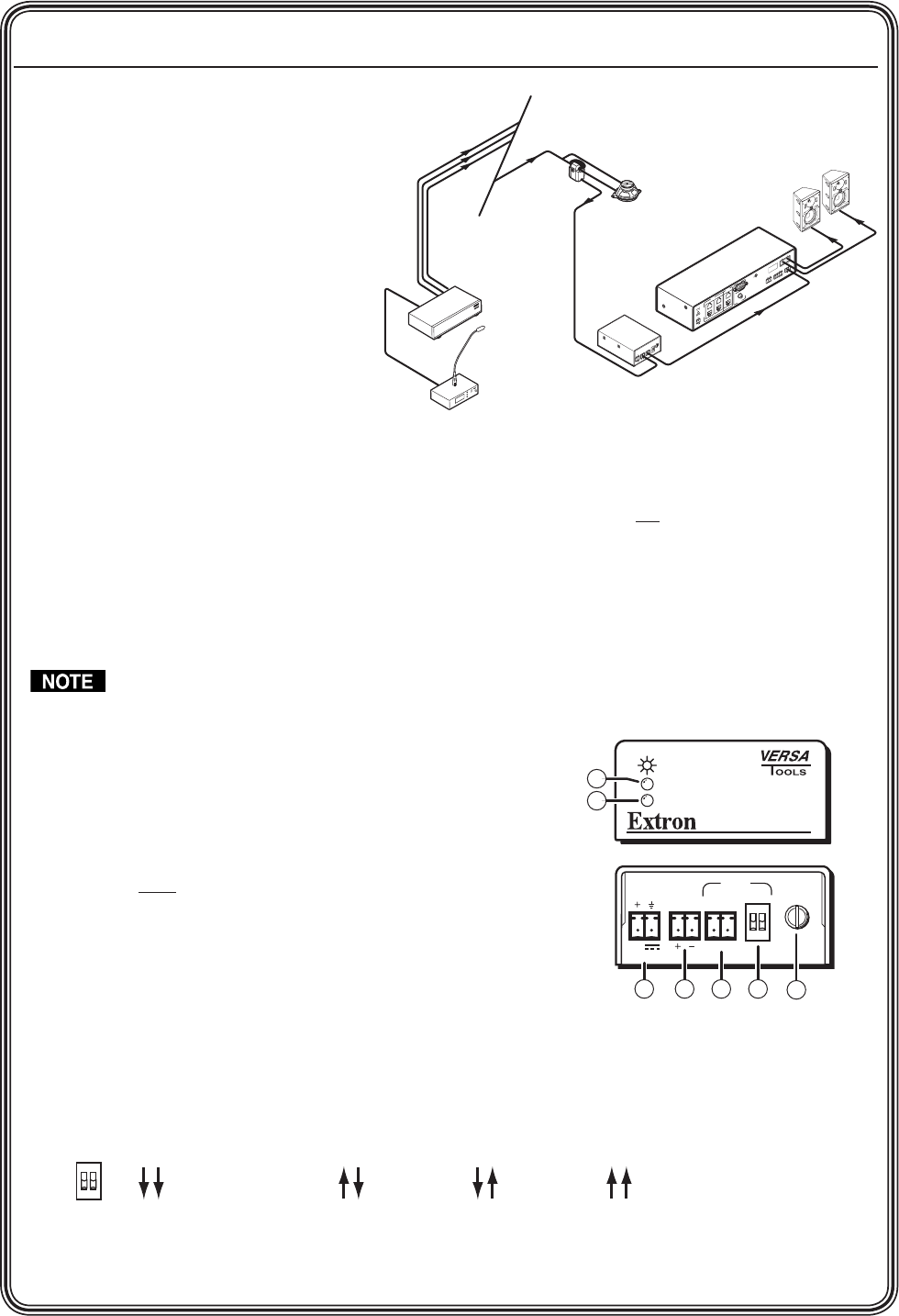
1
PPC 25 Priority Page Sensor • Installation Instructions
68-1437-01
Rev F
04 08
PPC 25 Installation Instructions
P
O
W
E
R
CN
O
P
A
G
IN
G
R
E
L
A
Y
D
E
L
A
Y
S
E
N
S
IT
IV
IT
Y
1
2
V
0
.2
A
M
A
X
O
N
1
2
L R
AUX
/M
IX
IN
D
O
N
O
T
G
R
O
U
N
D
O
R
S
H
O
R
T
S
P
E
A
K
E
R
O
U
T
P
U
T
S
!
1B
1A
I
N
P
U
T
S
O
U
T
P
U
T
S
2B
2A
3B
3A
RS
-232
M
L
C/IR
DC
VO
L
4/8 O
hm
s
AM
PLIFIED O
UTPUTS
V
O
L
/M
U
TE
Tx
ABC
Rx
IR12V
10V
POW
ER
1
2
V
3
A
M
A
X
U
S
L
I
S
T
E
D
17TT
AUDIO/VID
EO
APP
ARATUS
®
R
G
B
V
ID
E
OR
G
B
V
ID
E
O
Ceiling Mounted
Paging Speaker
Paging System
PPC 25
Priority
Page
Sensor
ClassroomAdmin Building
To Classroom
Paging Speakers
Relay Output
Remote
Vol/Mute
Control
Extron
PPC 25
Priority Page
Controller
Extron
PVS 204SA
Twisted Pair
Switcher
Extron
SI 26
Surface Mount
Speakers
PPC 25 Overview
The PPC 25 consists of the Priority Page
Controller and Priority Page Sensor.
Together they mute classroom audio for
the duration of an announcement that is
made over a Public Address (PA) system.
The Sensor connects to a PA speaker
lead and detects current flow when a
PA announcement is initiated.
The Sensor signal triggers the PPC 25
controller’s output relay to close. This
relay closure can connect to a PoleVault
™
switcher, a Mini Power Amplifier (MPA),
a MediaLink
™
Controller (MLC), or any
device with a contact closure type of
mute control or a configurable digital
input.
The output relay remains closed until the PA
announcement ends. It then opens, dropping
the mute signal and restoring the classroom audio.
For a PoleVault System, the output relay should connect only to the PVS 204SA and not the MLC. This requires no
software configuration.
If the Output Relay is connected to an MLC digital input, use Global Configurator software to configure the input
port, and set the monitoring conditions and actions to drive the desired mute function on the classroom audio device.
The PPC 25 Controller and Sensor are rated for use in plenum environments (any area utilized for air handling,
including areas above suspended ceilings and below raised floors). The PPC 25 Sensor assembly must be installed
in a UL-compliant junction box with a cover to meet the plenum rating requirement.
The PPC 25 works with traditional 25V or 70V and 4/8 ohm PA systems. It was not designed
for, and may not work properly with, systems using digital clocks and two-way intercoms.
Front and Rear Views of the PPC 25 Controller
a
Power-on LED — green when power is on
b
RELAY LED — amber when output relay is closed
c
POWER receptacle — 12 VDC, 33 mA. The unit does not ship
with a power supply. Power may be shared with another device.
Polarity must be observed.
d
PAGING SENSOR connector — for the Priority Page Sensor that
is located near a PA system speaker
e
RELAY OUT connector — connects to an amplifier or switcher
that has a contact closure type of mute control input, or to an MLC
device with a digital input. When a PA system announcement is
initiated, the output relay closes and remains closed for the duration of the announcement. The closed output
relay triggers the classroom audio mute function. When integrating the PPC 25 into a PoleVault System,
connect the output relay to the PVS 204SA Mute and Ground pins only (see diagram on page 2).
f
TIME switch — sets how long the output relay will remain closed after a PA announcement has ended. A
short time delay is necessary so that if the PA system announcer pauses briefly during the announcement, the
classroom audio is not restored prematurely. The 2-position DIP switch provides the following time settings:
g
SENSITIVITY adjustment — sets the sensitivity level for the signal arriving from the Priority
Page Sensor. The final setting depends on the type of paging system and the number of wire
loops on the Sensor (see page 2). Rotate clockwise to increase sensitivity and counterclockwise
to decrease sensitivity.
PPC 25
RELAY
7
2
3 4 5 6
1
POWER
CNO
PAGING
SENSOR
OUT
TIME
RELAY
SENSITIVITY
12V
0.5A MAX
ON
1
2
A Typical PPC 25 Installation
TIME
ON
1
2
= 2.0 sec (default) = 4.0 sec= 6.0 sec= 8.0 sec
